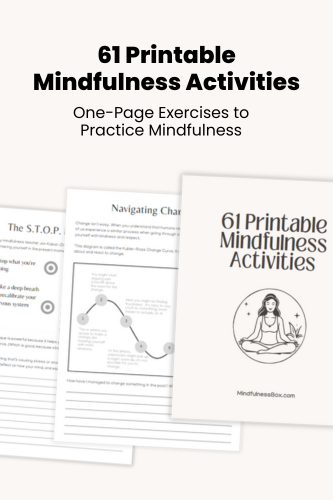Mindfulness with music is the art of applying present-moment awareness to music. Learn what mindful music listening is, what types of music can be used, and how to listen to music mindfully in 7 steps.
Ever listen to a song and feel like you were getting completely absorbed in the music? Noticing the different layers of sound, the different instruments, the tempo and textures and rhythm?
You may have been experiencing mindfulness with music.
Get dozens of one-page exercises to help practice mindfulness, meditation, gratitude, and self love. Perfect for printable handouts when teaching mindfulness to groups, students, or in the workplace.
To see examples, plus a full list of the 61 exercises included, click below.
Mindfulness is the art of paying attention deeply to the present moment, observing thoughts and emotions that arise without judgment. Music is a great vehicle for mindfulness practice because of how immerse it can be.
Let’s review what mindful music listening is, what types of music can be used, and how to do a mindful listening session.
Can I practice mindfulness through music?
Yes, you can definitely practice mindfulness with music.
In fact, music might help you be calmer and more present.
Studies show that music is good for the brain, even independent of any mindfulness practice. Music can slow your heart rate, make you calmer, and lead to less stress. Music has also been shown to evoke memories, repair brain damage, and may even make you smarter.
These benefits—calm, less stress, a slower heart rate—may help create an environment that’s more conducive to mindfulness.
Listening to music can help you connect with emotions and sensations, providing a deeper level of awareness. In addition, music can help to create a sense of spaciousness and peace.
Note that mindful listening isn’t exactly the same as flow, which shows up frequently with music, too. Flow is the state of becoming totally immersed in an activity you love to the point that you lose yourself in the activity.
Mindful listening is more intentional than that, and you never lose yourself (although you can become immersed). Even so, you keep a level of metacognition active at all times. Mindful listening involves not only listening carefully to all aspects of the music, observing not only the different sounds and rhythms, but also observing your own thoughts and feelings as they arise.
You’re not limited to “meditation music”

You might feel like mindful listening needs to be done with “spiritual” music, chanting monks, or at the very least, classical music.
Not the case.
You can listen to literally any type of music in your mindful music practice.
Yes, even heavy metal.
However, you may find the process goes easier with slower, calmer tracks that keep your heart rate down and aren’t too distracting for you to stay present. This is one reason that for many people, instrumental or classical music works well.
You might also experiment with music that evokes positive memories and good energy. For example, anything you loved listening to when you were growing up, or songs that your parents used to play. Just be mindful that songs you know well may cause more of your own thoughts, emotions and memories to bubble to the surface as you listen.
Finding the best songs for mindful listening
The music you choose for a “mindfulness listening” session is inherently personal.
For the purposes of writing this article, I pulled up a song I don’t know too well but have enjoyed recently: 6’s to 9’s by Big Wild. It’s got a massive soundscape with varied instruments and tempos and layers.
It’s not exactly calm-inducing, but it brings me a lot of positive energy.
I put on my noise-canceling headphones and hit play:
I noticed right off the bat that this felt different.
Normally, when I listen to music, I’m doing something else at the same time. My attention is split: I’m probably listening to music while working, or while making dinner.
As a result, it’s often possible to have no idea what the songs I listen to are actually about, because I’m not truly listening to the lyrics.
This time, I could feel the fullness of my attention focused on the song. There was more bandwidth available to devote to all the different aspects of the song: the lyrics, the different instruments, the changing tempos.
There was also my own experience to observe. How was my energy being affected? As the tempo ran up towards a big beat drop, I could feel a tingling sensation in my body.
It may work better for you to use a song you don’t know well, or one with a slower tempo, so you don’t get too caught up in your emotions.
Ultimately, the best songs for mindful listening are the songs and genres you’re willing to come back to again and again.
Experiment with different songs and styles and see what works best for you.
Looking for meditation music for mindfulness practice?
Check out the following meditation playlists and music for mindfulness on Spotify:
- Peaceful Meditation Playlist: Very calm. Reminds me of spa music.
- This is Meditation Music Zone: Diverse mindfulness playlist with entries from around the world.
- Mindfulness Music & Nature Sounds: Refreshing. More focused on nature-related sounds.
- Music for Mindfulness: Minimalist atmospheric songs for mindfulness.
How to listen to music mindfully (7 steps)

Follow the below steps and start with a single song, then adapt based on your experience.
- Find a comfortable place to sit or recline. No rules for how or where. Any quiet place where you can sit or lay down will do.
- Put on headphones. You can also just make sure you’re in a private room where you won’t be disturbed. Headphones are often the most immersive.
- Play a style of music you enjoy. It might be classical music or it might be acoustic pop or low-fi instrumental or psychedelic rock—truly anything. Ideally, it’s something relatively calm that has a positive effect on you. Note that if it’s a song you know well, the experience may be more challenging as more emotions and memories are likely to come up.
- Give your full attention to the music. Listen to all of the different aspects of the music: the lyrics, the instruments, the tempo, the texture. See how deep you can go with your observations. With mindful listening to music, what are you noticing that normally, you don’t notice?
- Observe your own reactions to the music. How does it make you feel? How are you reacting to the combination of music and mindfulness? What thoughts, memories or feelings are coming up? You may find that your mind wanders more frequently than you expected during the song.
- As your thoughts wander, bring your attention back. Your thoughts will wander—that’s ok. Gently acknowledge them, then bring your full attention back to the song.
- Take a moment after the song finishes. Process your experience when the song ends. What feelings and emotions came up? What was the experience like? How was it different from other times you’ve heard this song or style of music?
Listening to music with your full attention
To take a step back and make things a little simpler:
Observing mindfulness in music simply means giving your full, undivided attention to the songs you listen to.
As you observe the music, also observe any of your own feelings, thoughts and emotions that arise, then bring your attention back to the music.
And remember, this practice doesn’t have to be a part of “official” music mindfulness activities.
It can also mean new ways of enjoying songs you’ve loved for years as well as music you’ve just discovered.
So sit back, relax, put your favorite headphones on, and give your full attention to the music.
Frequently asked questions
How does music promote mindfulness?
Music may help you be less anxious and more present.
Even without any meditation practice, music has been proven to be beneficial to the brain. Music can lower your heart rate and make you calmer, all while reducing stress. Music has also been shown to stimulate memory recall and heal brain damage, among other things.
These advantages might assist in creating a more peaceful state of mind, which is advantageous to mindfulness.
Is listening to music meditative?
Music can help to focus and calm the mind.
When you’re focusing on the music, you’re less likely to be thinking about your day-to-day worries or concerns. This can help to create a more peaceful state of mind.
Additionally, if you’re reacting emotionally to the music, that can also be a form of mindfulness as you’re paying close attention to your own reactions and feelings.
What are examples of mindfulness music?
Mindfulness and music have a close relationship – many people find that listening to certain types of music can help them focus and be more present in the moment.
Mindfulness music can be any genre. However, many people prefer calmer music with a slower tempo, as it’s less distracting.
Examples include classical music, low-fi beats, and traditional instrumental meditation and relaxation music.

My mindfulness practice kicked off in 2016 with a ten-day silent retreat. Since then, I’ve read dozens of books about mindfulness and completed hundreds of hours of meditation. Thinking about what makes humans happy, calm, and peaceful is endlessly fascinating to me.


